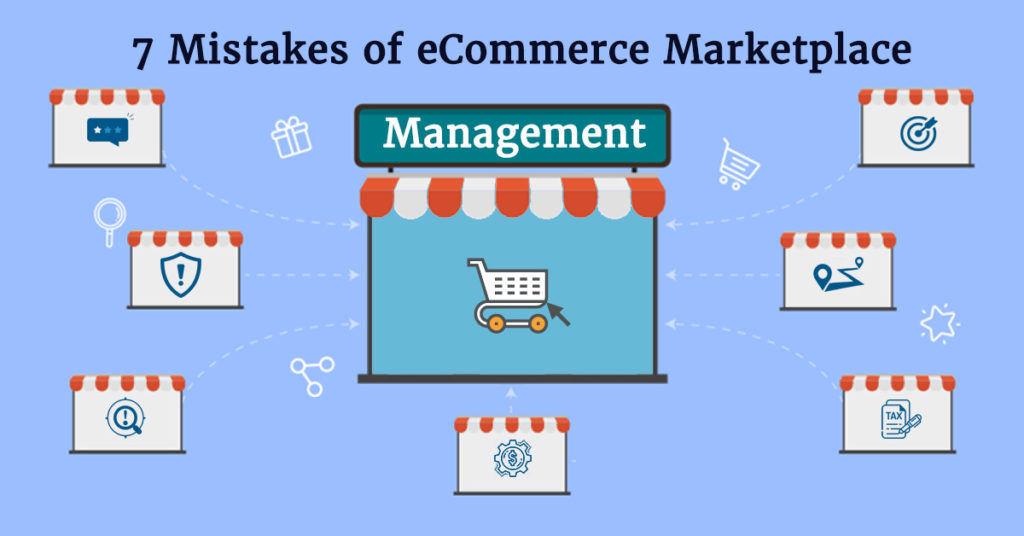
Customers have time and again exhibited their confidence in online marketplaces. The global digital buyer count has steadily risen through the past decade, now expected to cross 2.14 billion by 2021. Platforms like Amazon, eBay, Walmart, Rakuten, etc. are the dominating players in a landscape that’s set to make nearly $3.46 trillion in 2019.
Clearly, eCommerce markets have made online shopping and selling more approachable than ever. Owing to their utility, they have earned the trust of buyers and sellers worldwide. Unfortunately, the chances of succeeding in eCommerce marketplaces don’t grow with the opportunities.
Trying to stay ahead of the competitive market takes a lot of work. Supervising marketplace management services, optimizing product listings, Amazon/eBay/other platform-based pricing, updates- there’s a lot of juggling on the seller’s part. Amidst that chaos, mistakes slip in. If left unchecked, they balloon into issues that can fatally harm a business.
On that account, we have come up with seven critical marketplace management mistakes that eStores must avoid at all costs. Take a look!
7 Marketplaces Management Mistakes to Steer Clear of
1. Ignoring Negative Reviews

Reviews carry equal importance for buyers and sellers alike.
- 95% of customers read reviews online before buying any product.
- 71% feel that knowing about the feedback makes them more comfortable when purchasing a product.
- 68% of them admit to explicitly looking for problems in buyer experience.
Ergo, reviews are a customer’s weapon against Buyer’s Remorse. Even a single unfavorable opinion has the power to deter a customer from making a purchase. Many well-established Amazon product listings have suffered because of minimal poor feedback.
Depending on the marketplace you’re using, the process of dealing with reviews also changes. However, the basic principle stays constant- Never Leave a Negative Review Unattended. That raises questions on your after-sale customer services.
In fact, 89% of customers read businesses’ replies to reviews. It helps them determine whether a company cares about their customers or not.
On encountering a negative review, here’s what you should do.
- Try to get the reviewer to change/delete it
- Ask the marketplace to remove it
- Comment on it publicly
Trying to get a reviewer to change their mind is tricky. First, you need to get the customer’s contact information, which isn’t easily accessible to sellers in most online marketplaces. Then, you need to eliminate the reason for the poor ratings.
And, lastly, you have to convince the customer to change their feedback to a positive one or delete it entirely. While effective, this method takes time and effort.
Expecting any online marketplace to remove bad reviews is mostly futile unless you have a solid reason. For instance, if the criticism is unjustified, or the customer gave positive feedback with a 1-star rating, asking the marketplace for help might work.
As a last resort, you should comment publicly on the review. Share your opinion on the matter. Put the criticism in perspective. That’ll give other prospective buyers the context to assess the situation and fairly judge your product/service.
2. Not Verifying Product Details
Listing discrepancies are a customer satisfaction nightmare.
For instance, take an Amazon/eBay product listing that displays some wrong information about the product’s color. It could be an entirely honest mistake, a mistyping error, the result of a distracted move, etc. However, if it is visible to the customer, they will take ‘said wrong information’ at face value. They will expect to be served with what they see.
The result- a disgruntled customer who feels cheated, leading to a bad review and a spiral of negative consequences. That’s why it’s essential to verify your product listings on all channels where your eStore features.
Product listing challenges have various forms. Some common ones include-
- Duplicate listings
- Keyword misuse
- Wrong product key identifier
- Wrong category
- Typo errors in the product title, description, highlighted phrases, or price
Discrepancies in product pages across different marketplaces can also negatively impact a customer’s perception of your store. That’s why maintaining consistency across different channels is considered one of the most vital marketplace management services.
3. Poor Risk Management

Mishaps are all too common in the world of eCommerce. However, certain not-so-obvious risks can cause severe setbacks to an eStore that’s not prepared to handle them.
For that very reason, it’s best to practice proactive risk management.
Technically, sellers should only have to worry about two things-
- Making sure that customers got the goods/services they paid for
- Protecting yourself from fraud
However, in reality, there is a lot more that needs taking care of. Think of issues like transaction risks, spam buyer accounts, promo & offer abuse, data breaches, etc. There are too many verticals to risk assessment for eCommerce. That’s why many leading eCommerce companies choose to hire marketplace management services for this purpose.
For instance, consider chargeback issues. Between placing the order and delivering it to the buyer’s doorstep, many problems can lead to a valid refund request. The purchase could have been made with a stolen card. The product may differ from the description or be entirely different from the original order.
There could be clerical errors. Whatever the reason be, you will need to pay the transaction amount plus a chargeback fee to the marketplace.
If it happens too frequently, you may expect to be buried in chargeback fees. Not an ideal situation, is it? So, have the necessary precautions in place to protect your online store from unnecessary risks.
4. Over Optimization of Price
Price strategy plays a critical role in increasing competitive advantage. Often, when many people are selling the same products, there’s little to separate their proposition from yours. That’s where price optimization comes in handy.
Businesses achieve their gains through various methods like cost-cutting, outsourcing, process reengineering, etc. Many companies choose to focus on serving their most profitable consumer segments. Many others market their products with specialized features, variants, and services to entice the consumer. The end goal for all of them remains the same- to earn superior profits.
Usually, online sellers conduct market research, compare prices for similar products and set a value that seems appropriate. Unfortunately, mistakes like miscalculated selling fees, shipping charges, etc. occur too frequently. At the same time, the lack of proper research leads businesses towards certain counter-intuitive price optimization moves. Keeping that in mind, it’s necessary to rethink your pricing strategy, to eliminate any chances of over-optimization.
- Don’t base prices on your costs; base them on customer’s perception of the product’s value
- Use your unique value proposition to identify & justify the price
- Use marketplace pricing only as a last resort
- Don’t expect same profit margins across varying product lines
- Don’t apply similar price optimization strategies on different product lines
- Change the pricing strategy for various market segments/consumer demographics
- Adopt the pricing model according to changing customer preferences, manufacturer costs, and market environment
- Forecast and prepare for competitor reaction before replacing price models
- Base your prices on hard data, i.e. customer surveys, analysis, competitor reviews, etc.
Also, the marketplace price constraints can affect how your product performs. For instance, when optimizing price for eBay product listings, pay heed to what their pricing and tax rules are. Integrate them into your strategy to maximize profits.
5. Skipping Tax Settings
If you are a merchant, you have the liability of sales tax on your head. However, when it comes to figuring out tax settings, most sellers only wake up when an audit is looming overhead. That’s not only bad practice in general but also dangerous to your business.
Take the example of Amazon. This marketplace has a robust system in place for tax collection. It puts sellers in a good position. It provides enterprise-level documentation, provisions for storing information, and guidelines on tax collection as well.
All you must do is collect the right tax on your sales, and file & submit them timely. Additionally, remember to update your product listings (on Amazon, eBay, or other marketplaces) accordingly.
Fail to do so, and you’ll be paying the taxes out of your pocket. Not ideal, right?
So, don’t forget to understand and set up tax settings for your eStore. And, while you’re at it, pay attention to particulars, like-
- Tax registration in the states where you’re collecting tax on sales
- Managing exemption certificates for taxes
- Proper sales tax reporting, form-filling, and timely submission
- Staying updated on changing tax rules for the marketplaces you use
6. Tracking Vanity Metrics

The worst kind of data is one that makes sellers feel good but doesn’t contribute to solving problems. The primary attribute of vanity metrics is that they cause either confusion or ambiguity, but never relief. They leave speculation and guesses on the table, but no clear course of action.
Actionable metrics are the ones that answer questions. They can help determine why and how your business is losing/gaining customers & revenue. They help in identifying your key elements that customers like and the ones they don’t. They should answer the following in the context of any changes you make to your eCommerce store-
- Should you continue or stop?
- Is there a need to change the strategy?
- Do you have to invest more time or money?
Of course, it calls for digging deeper. But, taking a step away from vanity metrics will help you focus on impactful & actionable insights. So, stop looking at Facebook & Twitter follower count, page views, email opening rate, or subscriber count. Divert your attention to engagement rates, click-through rates, social shares, bounce rates, active user count, etc.
7. Losing Focus
The cost of distraction can harm even the best revenue-generating businesses. Especially in eCommerce, if you try to solve all pain points for a customer at once, you will falter. Doing too much at once will affect your vertical growth and alter consumer perception of your brand.
It’s necessary to point out that many companies don’t see themselves going awry. Sometimes, the reason is immediate and undetermined scaling. Sometimes, it’s the variety and number of details that they have to handle. And, sometimes, it’s the inability to lock on the right priorities.
Whatever the reasons may be, when an online store gets too fickle-natured, their service standards suffer the most.
Here’s how you can keep your eStore from losing focus.
- Define what focus means for your eStore on any particular marketplace
- Be rational when assessing different markets and write your eStore goals accordingly
- Be very clear about the problem you are solving; avoid getting distracted
- Focus on a core purpose, specific needs, particular customer demographics
- Provide impeccable service
With refined focus, it becomes easier to find a niche and establish yourself in the marketplace.
The Lesson- Staying Sin-Free Isn’t Easy, But it Sure Pays Off Well
The eCommerce landscape is vast and complicated. It changes too frequently. The competition is tough. And, amidst all that, creating and maintaining an eCommerce store on multiple marketplaces without making any mistakes seems improbable.
Remember- everyone makes mistakes. So will you. However, as long as they aren’t as critical as these seven and are checked & rectified on time, you will be fine. Having said that, a little help is always appreciated, and we understand that.
Team4eCom houses a team of professionals adept at handling all eCommerce-related tasks. Our marketplace management services are designed to help you succeed while educating you about the best practices. We have also been recognized by DesignRush among the best California eCommerce Marketing agencies. From consulting on eCommerce strategies to optimizing eBay / Amazon product listings, we can do it all. Write to us at info@team4ecom.com to learn more about how we can help.

 +44 203 514 2601
+44 203 514 2601 +1 585 283 0055
+1 585 283 0055